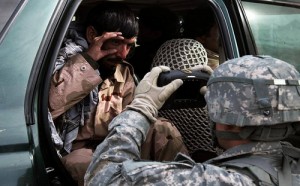Kabul Suicide Attack Kills Foreign Guards in Buffer Between Afghans and Americans
On the surface, today’s suicide attack in Kabul looks like many others, but some details disclosed in the New York Times story on the attack illustrate the lengths to which the US has been forced to go to protect against green on blue attacks in which Afghans kill Americans. The attack took place at Camp Gibson. Those killed were described by the Times as guarding buildings occupied by trainers from Dyncorp at a facility dedicated to counternarcotics operations. Three guards who were killed were from Nepal and one was from Peru, according to the Times. The Washington Post says two were Nepalese, one was Filipino and one was of unknown nationality. The Times explains why there are both Afghan and foreign guards:
Security guards from countries like Nepal and Peru are common at foreign military and diplomatic compounds in Afghanistan. The guards, many of whom are Nepalese veterans of the British Army’s Gurkha regiments, usually provide a layer of security behind the Afghan police and security guards, who man the first line of checkpoints.
The setup is used because of deep concerns about the efficacy and loyalty of the police, a force that is riddled with corruption and drug use. It also provides a final layer of defense should Afghan guards turn on the foreigners they are guarding.
So the outside layer of security consists of Afghan personnel, but the US must use a ring of foreign security personnel to protect against the Afghans turning their weapons on the US personnel they are “guarding”. And it appears that the Afghan who carried out this attack had some help among his fellows in that outside ring of security. The attacker was Afghan, but the uniform he wore matched those of the foreign guards rather than Afghans:
An official from the NATO-led military coalition said there were suspicions that the attacker had inside help. An Afghan in a uniform worn by foreign guards would “strike me as more suspicious, not less, right?” said the official, who spoke on the condition of anonymity to avoid antagonizing his Afghan counterparts.
The Times article points out that previous attacks aimed at US personnel have killed only foreign guards, so this layered security situation likely has been described before, but I didn’t have a full appreciation of how and why it is set up in this way until today.
An interesting detail offered by ToloNews is that the attacker was not new to the facility:
On condition of anonymity a security official said that the suicide bomber was an Afghan security guard working alongside foreign contractors.
“The suicide bomber was an Afghan security guard working alongside foreigners at the anti-narcotics office for many years,” said the security official.
It would be interesting to know whether the attacker had planned all along to carry out such an attack or if he only recently decided to switch sides.
Meanwhile, the “auditing” of ballots from the runoff is proceeding much more slowly than the target rate, so look for more delays before a “final” vote count is released.

